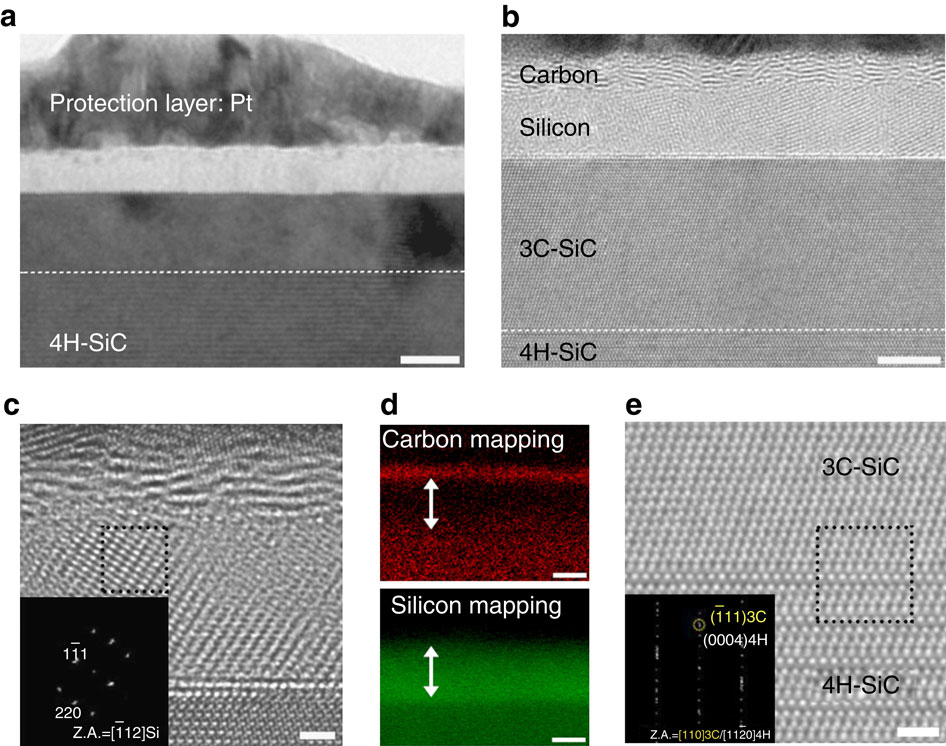当前位置:
X-MOL 学术
›
Nat. Commun.
›
论文详情
Our official English website, www.x-mol.net, welcomes your
feedback! (Note: you will need to create a separate account there.)
Laser-induced phase separation of silicon carbide.
Nature Communications ( IF 14.7 ) Pub Date : 2016-11-30 , DOI: 10.1038/ncomms13562 Insung Choi 1, 2 , Hu Young Jeong 3, 4 , Hyeyoung Shin 5 , Gyeongwon Kang 5 , Myunghwan Byun 1 , Hyungjun Kim 5 , Adrian M Chitu 6 , James S Im 6 , Rodney S Ruoff 7, 8 , Sung-Yool Choi 2 , Keon Jae Lee 1, 7
Nature Communications ( IF 14.7 ) Pub Date : 2016-11-30 , DOI: 10.1038/ncomms13562 Insung Choi 1, 2 , Hu Young Jeong 3, 4 , Hyeyoung Shin 5 , Gyeongwon Kang 5 , Myunghwan Byun 1 , Hyungjun Kim 5 , Adrian M Chitu 6 , James S Im 6 , Rodney S Ruoff 7, 8 , Sung-Yool Choi 2 , Keon Jae Lee 1, 7
Affiliation

|
Understanding the phase separation mechanism of solid-state binary compounds induced by laser-material interaction is a challenge because of the complexity of the compound materials and short processing times. Here we present xenon chloride excimer laser-induced melt-mediated phase separation and surface reconstruction of single-crystal silicon carbide and study this process by high-resolution transmission electron microscopy and a time-resolved reflectance method. A single-pulse laser irradiation triggers melting of the silicon carbide surface, resulting in a phase separation into a disordered carbon layer with partially graphitic domains (∼2.5 nm) and polycrystalline silicon (∼5 nm). Additional pulse irradiations cause sublimation of only the separated silicon element and subsequent transformation of the disordered carbon layer into multilayer graphene. The results demonstrate viability of synthesizing ultra-thin nanomaterials by the decomposition of a binary system.
中文翻译:

激光诱导碳化硅相分离。
由于化合物材料的复杂性和加工时间短,理解激光-材料相互作用引起的固态二元化合物的相分离机制是一个挑战。在这里,我们提出了氯化氙准分子激光诱导熔融介导的单晶碳化硅相分离和表面重建,并通过高分辨率透射电子显微镜和时间分辨反射方法研究了这一过程。单脉冲激光照射触发碳化硅表面熔化,导致相分离成具有部分石墨域(~2.5 nm)和多晶硅(~5 nm)的无序碳层。额外的脉冲辐射仅导致分离的硅元素升华,并随后将无序碳层转变为多层石墨烯。结果证明了通过二元系统分解合成超薄纳米材料的可行性。
更新日期:2016-12-02
中文翻译:

激光诱导碳化硅相分离。
由于化合物材料的复杂性和加工时间短,理解激光-材料相互作用引起的固态二元化合物的相分离机制是一个挑战。在这里,我们提出了氯化氙准分子激光诱导熔融介导的单晶碳化硅相分离和表面重建,并通过高分辨率透射电子显微镜和时间分辨反射方法研究了这一过程。单脉冲激光照射触发碳化硅表面熔化,导致相分离成具有部分石墨域(~2.5 nm)和多晶硅(~5 nm)的无序碳层。额外的脉冲辐射仅导致分离的硅元素升华,并随后将无序碳层转变为多层石墨烯。结果证明了通过二元系统分解合成超薄纳米材料的可行性。




















































 京公网安备 11010802027423号
京公网安备 11010802027423号